BISY3005: Knowledge Management for World Bank Case Study Report
VerifiedAdded on 2022/08/20
|11
|2868
|18
Report
AI Summary
This report provides a detailed analysis of the World Bank's knowledge management (KM) initiatives. It begins with an introduction to KM, emphasizing its importance in creating, sharing, and utilizing knowledge within organizations. The report then describes the World Bank as an international financial institution, outlining its goals and the problems it faced, which led to the implementation of a knowledge management system (KMS). The report details the nature of the KM initiative, the process of selecting it, and the four key knowledge areas enabled: synthesis, discussion, personal thinking, and information. The report also explores the difficulties encountered during KMS implementation, including employee motivation, technological advancements, measuring knowledge contributions, and maintaining security. Furthermore, it assesses the successes of the KM initiative, highlighting improvements in operational efficiency, faster cycle times, enhanced client services, and employee satisfaction. The report concludes by emphasizing the importance of KM in achieving organizational goals such as competitive advantage and continuous improvement.
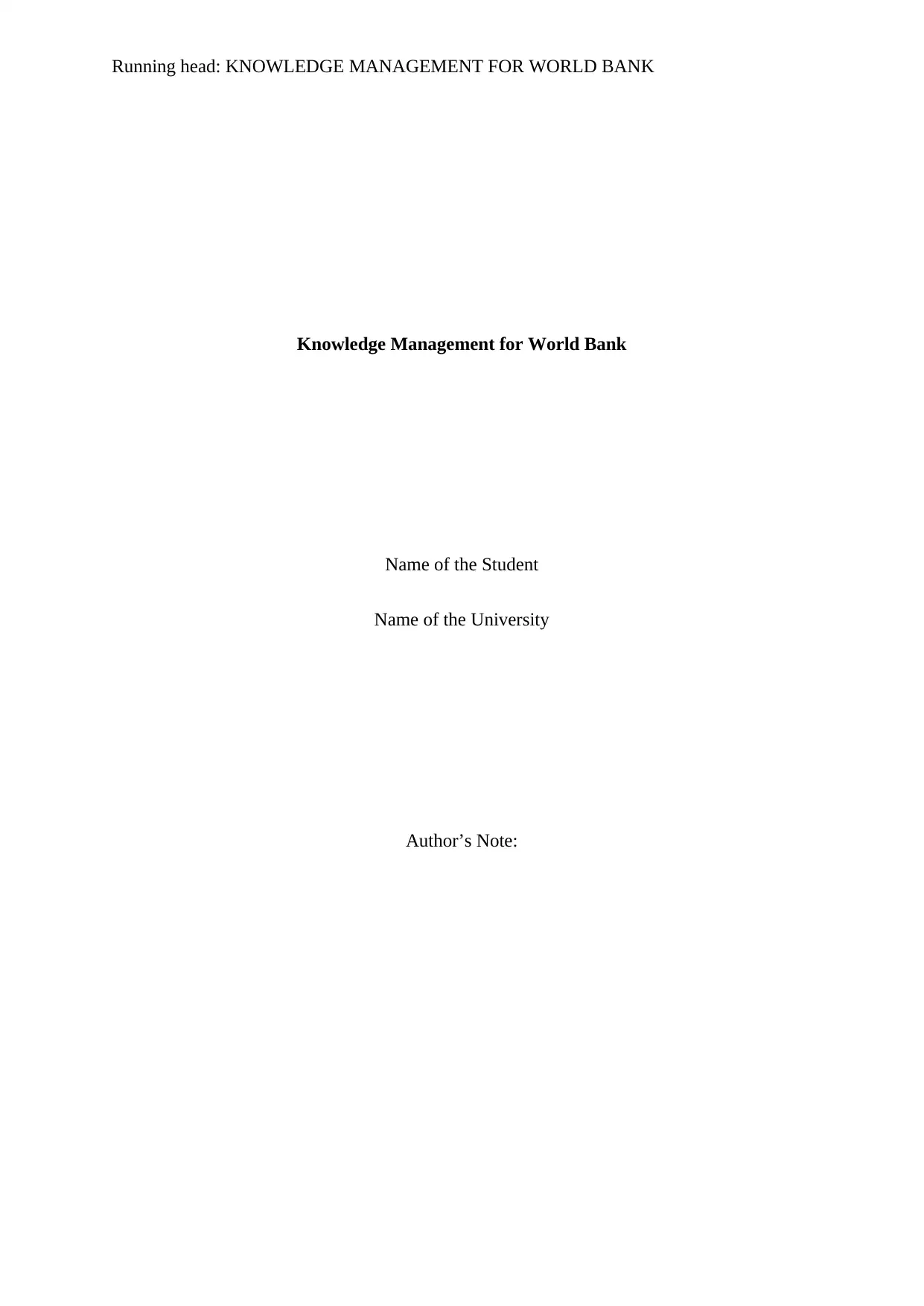
Running head: KNOWLEDGE MANAGEMENT FOR WORLD BANK
Knowledge Management for World Bank
Name of the Student
Name of the University
Author’s Note:
Knowledge Management for World Bank
Name of the Student
Name of the University
Author’s Note:
Paraphrase This Document
Need a fresh take? Get an instant paraphrase of this document with our AI Paraphraser
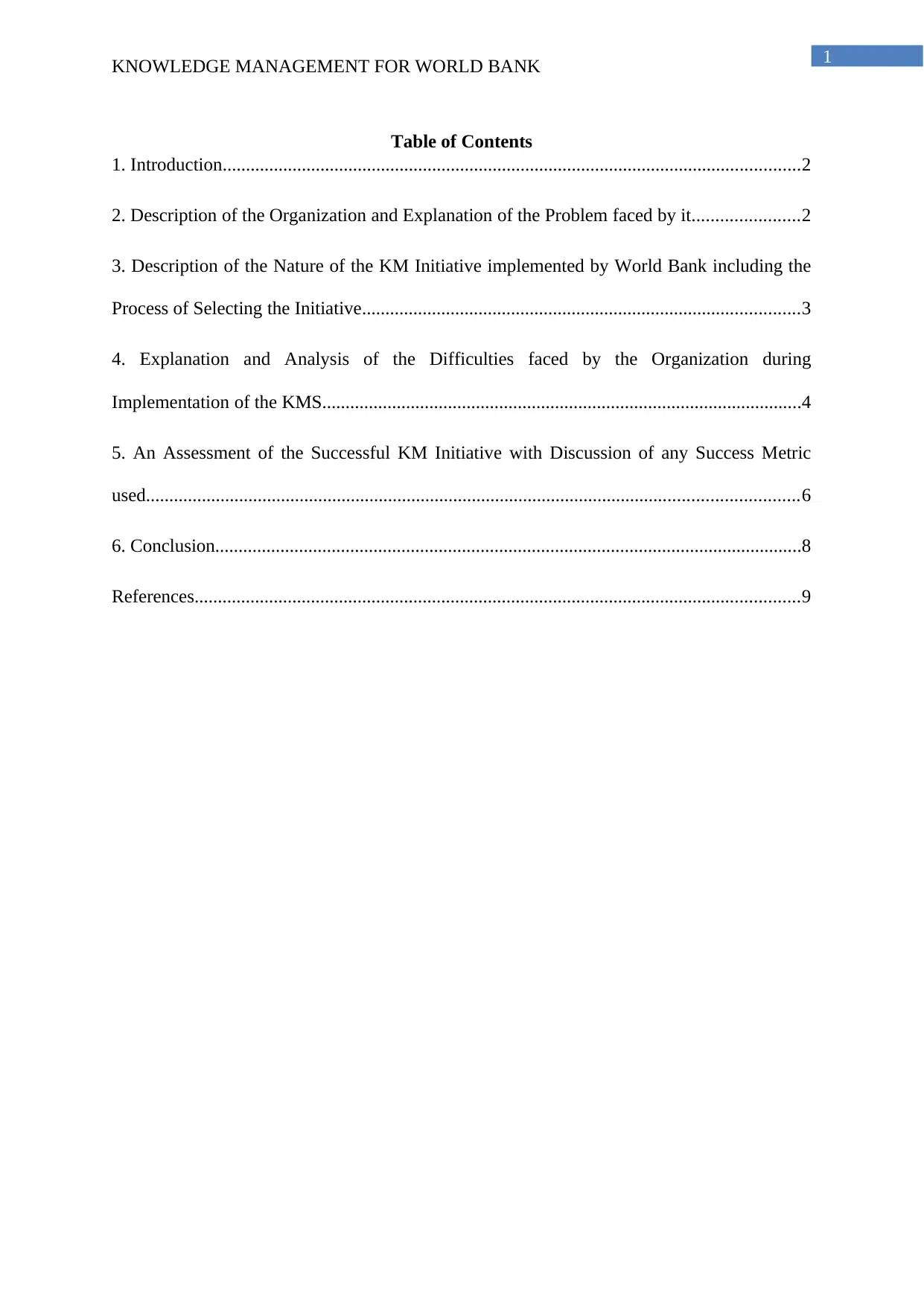
1
KNOWLEDGE MANAGEMENT FOR WORLD BANK
Table of Contents
1. Introduction............................................................................................................................2
2. Description of the Organization and Explanation of the Problem faced by it.......................2
3. Description of the Nature of the KM Initiative implemented by World Bank including the
Process of Selecting the Initiative..............................................................................................3
4. Explanation and Analysis of the Difficulties faced by the Organization during
Implementation of the KMS.......................................................................................................4
5. An Assessment of the Successful KM Initiative with Discussion of any Success Metric
used............................................................................................................................................6
6. Conclusion..............................................................................................................................8
References..................................................................................................................................9
KNOWLEDGE MANAGEMENT FOR WORLD BANK
Table of Contents
1. Introduction............................................................................................................................2
2. Description of the Organization and Explanation of the Problem faced by it.......................2
3. Description of the Nature of the KM Initiative implemented by World Bank including the
Process of Selecting the Initiative..............................................................................................3
4. Explanation and Analysis of the Difficulties faced by the Organization during
Implementation of the KMS.......................................................................................................4
5. An Assessment of the Successful KM Initiative with Discussion of any Success Metric
used............................................................................................................................................6
6. Conclusion..............................................................................................................................8
References..................................................................................................................................9
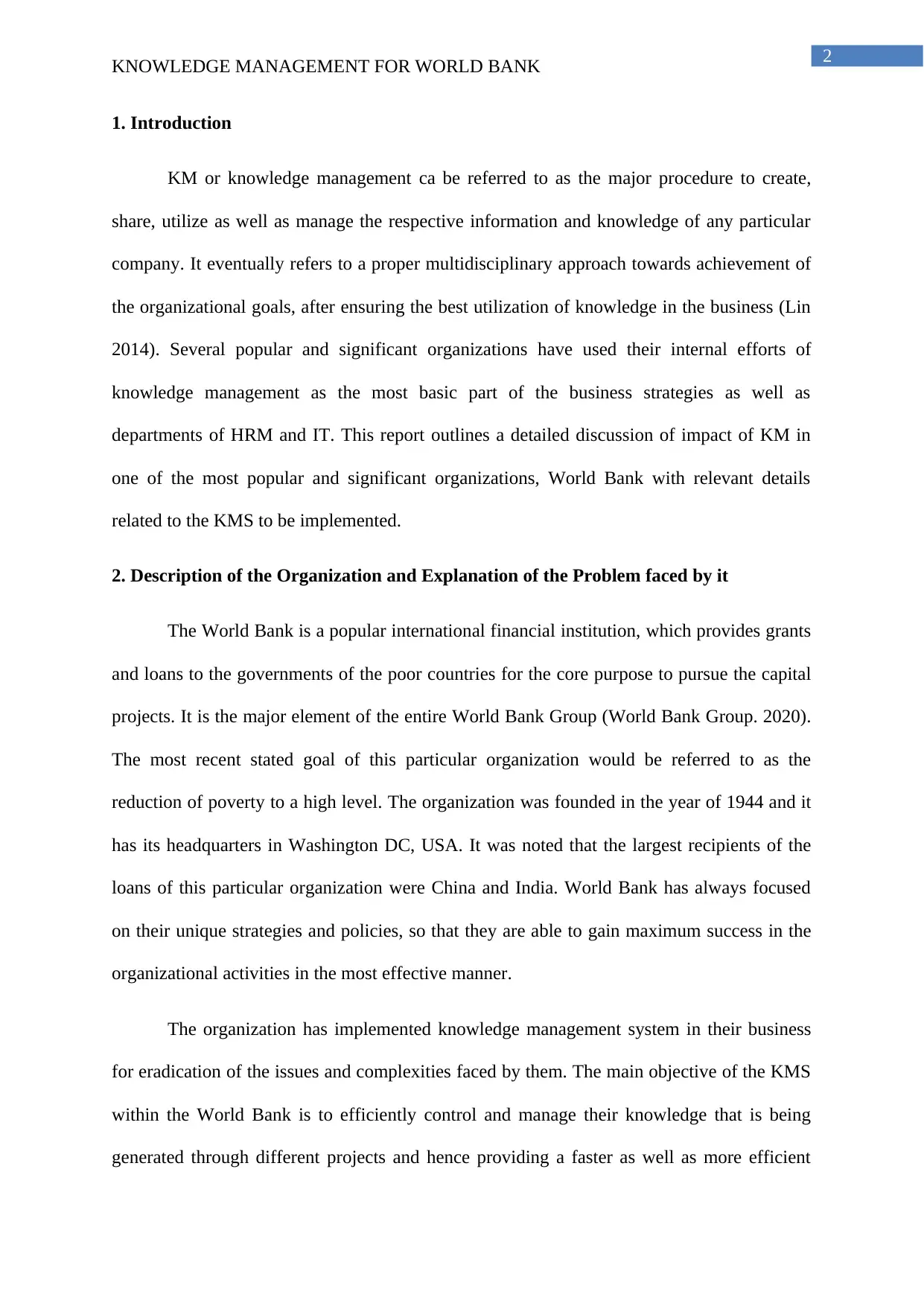
2
KNOWLEDGE MANAGEMENT FOR WORLD BANK
1. Introduction
KM or knowledge management ca be referred to as the major procedure to create,
share, utilize as well as manage the respective information and knowledge of any particular
company. It eventually refers to a proper multidisciplinary approach towards achievement of
the organizational goals, after ensuring the best utilization of knowledge in the business (Lin
2014). Several popular and significant organizations have used their internal efforts of
knowledge management as the most basic part of the business strategies as well as
departments of HRM and IT. This report outlines a detailed discussion of impact of KM in
one of the most popular and significant organizations, World Bank with relevant details
related to the KMS to be implemented.
2. Description of the Organization and Explanation of the Problem faced by it
The World Bank is a popular international financial institution, which provides grants
and loans to the governments of the poor countries for the core purpose to pursue the capital
projects. It is the major element of the entire World Bank Group (World Bank Group. 2020).
The most recent stated goal of this particular organization would be referred to as the
reduction of poverty to a high level. The organization was founded in the year of 1944 and it
has its headquarters in Washington DC, USA. It was noted that the largest recipients of the
loans of this particular organization were China and India. World Bank has always focused
on their unique strategies and policies, so that they are able to gain maximum success in the
organizational activities in the most effective manner.
The organization has implemented knowledge management system in their business
for eradication of the issues and complexities faced by them. The main objective of the KMS
within the World Bank is to efficiently control and manage their knowledge that is being
generated through different projects and hence providing a faster as well as more efficient
KNOWLEDGE MANAGEMENT FOR WORLD BANK
1. Introduction
KM or knowledge management ca be referred to as the major procedure to create,
share, utilize as well as manage the respective information and knowledge of any particular
company. It eventually refers to a proper multidisciplinary approach towards achievement of
the organizational goals, after ensuring the best utilization of knowledge in the business (Lin
2014). Several popular and significant organizations have used their internal efforts of
knowledge management as the most basic part of the business strategies as well as
departments of HRM and IT. This report outlines a detailed discussion of impact of KM in
one of the most popular and significant organizations, World Bank with relevant details
related to the KMS to be implemented.
2. Description of the Organization and Explanation of the Problem faced by it
The World Bank is a popular international financial institution, which provides grants
and loans to the governments of the poor countries for the core purpose to pursue the capital
projects. It is the major element of the entire World Bank Group (World Bank Group. 2020).
The most recent stated goal of this particular organization would be referred to as the
reduction of poverty to a high level. The organization was founded in the year of 1944 and it
has its headquarters in Washington DC, USA. It was noted that the largest recipients of the
loans of this particular organization were China and India. World Bank has always focused
on their unique strategies and policies, so that they are able to gain maximum success in the
organizational activities in the most effective manner.
The organization has implemented knowledge management system in their business
for eradication of the issues and complexities faced by them. The main objective of the KMS
within the World Bank is to efficiently control and manage their knowledge that is being
generated through different projects and hence providing a faster as well as more efficient
⊘ This is a preview!⊘
Do you want full access?
Subscribe today to unlock all pages.

Trusted by 1+ million students worldwide
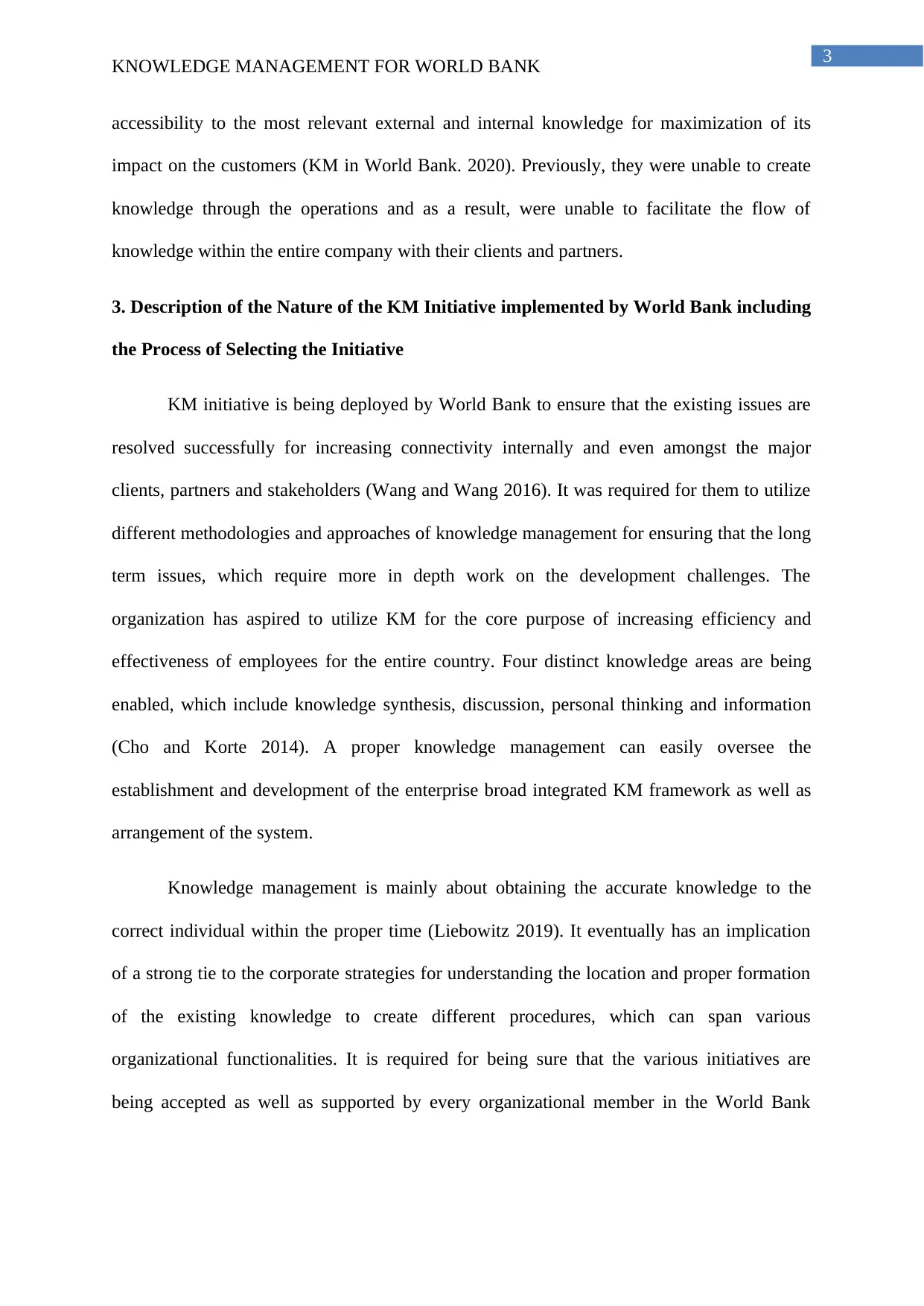
3
KNOWLEDGE MANAGEMENT FOR WORLD BANK
accessibility to the most relevant external and internal knowledge for maximization of its
impact on the customers (KM in World Bank. 2020). Previously, they were unable to create
knowledge through the operations and as a result, were unable to facilitate the flow of
knowledge within the entire company with their clients and partners.
3. Description of the Nature of the KM Initiative implemented by World Bank including
the Process of Selecting the Initiative
KM initiative is being deployed by World Bank to ensure that the existing issues are
resolved successfully for increasing connectivity internally and even amongst the major
clients, partners and stakeholders (Wang and Wang 2016). It was required for them to utilize
different methodologies and approaches of knowledge management for ensuring that the long
term issues, which require more in depth work on the development challenges. The
organization has aspired to utilize KM for the core purpose of increasing efficiency and
effectiveness of employees for the entire country. Four distinct knowledge areas are being
enabled, which include knowledge synthesis, discussion, personal thinking and information
(Cho and Korte 2014). A proper knowledge management can easily oversee the
establishment and development of the enterprise broad integrated KM framework as well as
arrangement of the system.
Knowledge management is mainly about obtaining the accurate knowledge to the
correct individual within the proper time (Liebowitz 2019). It eventually has an implication
of a strong tie to the corporate strategies for understanding the location and proper formation
of the existing knowledge to create different procedures, which can span various
organizational functionalities. It is required for being sure that the various initiatives are
being accepted as well as supported by every organizational member in the World Bank
KNOWLEDGE MANAGEMENT FOR WORLD BANK
accessibility to the most relevant external and internal knowledge for maximization of its
impact on the customers (KM in World Bank. 2020). Previously, they were unable to create
knowledge through the operations and as a result, were unable to facilitate the flow of
knowledge within the entire company with their clients and partners.
3. Description of the Nature of the KM Initiative implemented by World Bank including
the Process of Selecting the Initiative
KM initiative is being deployed by World Bank to ensure that the existing issues are
resolved successfully for increasing connectivity internally and even amongst the major
clients, partners and stakeholders (Wang and Wang 2016). It was required for them to utilize
different methodologies and approaches of knowledge management for ensuring that the long
term issues, which require more in depth work on the development challenges. The
organization has aspired to utilize KM for the core purpose of increasing efficiency and
effectiveness of employees for the entire country. Four distinct knowledge areas are being
enabled, which include knowledge synthesis, discussion, personal thinking and information
(Cho and Korte 2014). A proper knowledge management can easily oversee the
establishment and development of the enterprise broad integrated KM framework as well as
arrangement of the system.
Knowledge management is mainly about obtaining the accurate knowledge to the
correct individual within the proper time (Liebowitz 2019). It eventually has an implication
of a strong tie to the corporate strategies for understanding the location and proper formation
of the existing knowledge to create different procedures, which can span various
organizational functionalities. It is required for being sure that the various initiatives are
being accepted as well as supported by every organizational member in the World Bank
Paraphrase This Document
Need a fresh take? Get an instant paraphrase of this document with our AI Paraphraser
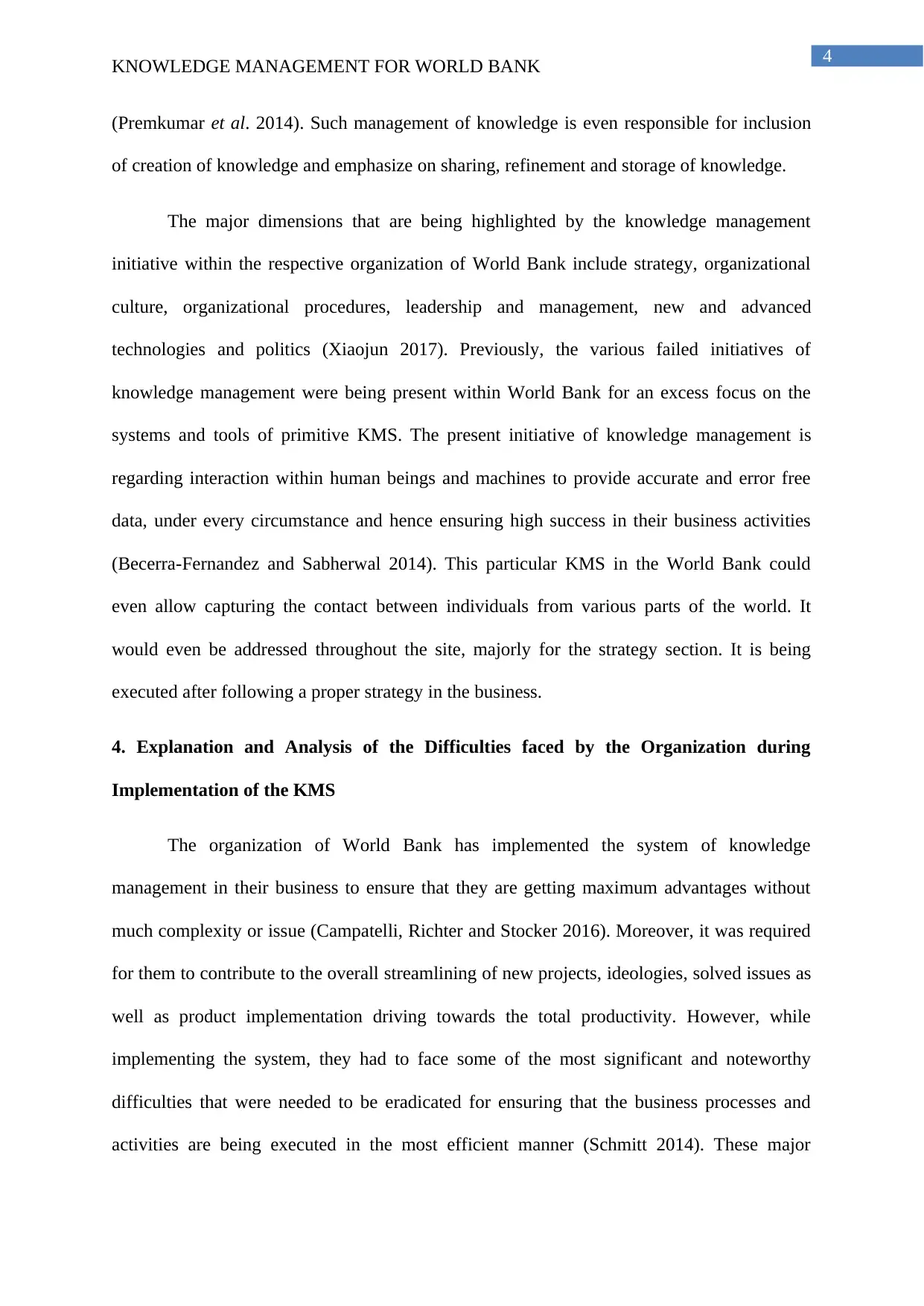
4
KNOWLEDGE MANAGEMENT FOR WORLD BANK
(Premkumar et al. 2014). Such management of knowledge is even responsible for inclusion
of creation of knowledge and emphasize on sharing, refinement and storage of knowledge.
The major dimensions that are being highlighted by the knowledge management
initiative within the respective organization of World Bank include strategy, organizational
culture, organizational procedures, leadership and management, new and advanced
technologies and politics (Xiaojun 2017). Previously, the various failed initiatives of
knowledge management were being present within World Bank for an excess focus on the
systems and tools of primitive KMS. The present initiative of knowledge management is
regarding interaction within human beings and machines to provide accurate and error free
data, under every circumstance and hence ensuring high success in their business activities
(Becerra-Fernandez and Sabherwal 2014). This particular KMS in the World Bank could
even allow capturing the contact between individuals from various parts of the world. It
would even be addressed throughout the site, majorly for the strategy section. It is being
executed after following a proper strategy in the business.
4. Explanation and Analysis of the Difficulties faced by the Organization during
Implementation of the KMS
The organization of World Bank has implemented the system of knowledge
management in their business to ensure that they are getting maximum advantages without
much complexity or issue (Campatelli, Richter and Stocker 2016). Moreover, it was required
for them to contribute to the overall streamlining of new projects, ideologies, solved issues as
well as product implementation driving towards the total productivity. However, while
implementing the system, they had to face some of the most significant and noteworthy
difficulties that were needed to be eradicated for ensuring that the business processes and
activities are being executed in the most efficient manner (Schmitt 2014). These major
KNOWLEDGE MANAGEMENT FOR WORLD BANK
(Premkumar et al. 2014). Such management of knowledge is even responsible for inclusion
of creation of knowledge and emphasize on sharing, refinement and storage of knowledge.
The major dimensions that are being highlighted by the knowledge management
initiative within the respective organization of World Bank include strategy, organizational
culture, organizational procedures, leadership and management, new and advanced
technologies and politics (Xiaojun 2017). Previously, the various failed initiatives of
knowledge management were being present within World Bank for an excess focus on the
systems and tools of primitive KMS. The present initiative of knowledge management is
regarding interaction within human beings and machines to provide accurate and error free
data, under every circumstance and hence ensuring high success in their business activities
(Becerra-Fernandez and Sabherwal 2014). This particular KMS in the World Bank could
even allow capturing the contact between individuals from various parts of the world. It
would even be addressed throughout the site, majorly for the strategy section. It is being
executed after following a proper strategy in the business.
4. Explanation and Analysis of the Difficulties faced by the Organization during
Implementation of the KMS
The organization of World Bank has implemented the system of knowledge
management in their business to ensure that they are getting maximum advantages without
much complexity or issue (Campatelli, Richter and Stocker 2016). Moreover, it was required
for them to contribute to the overall streamlining of new projects, ideologies, solved issues as
well as product implementation driving towards the total productivity. However, while
implementing the system, they had to face some of the most significant and noteworthy
difficulties that were needed to be eradicated for ensuring that the business processes and
activities are being executed in the most efficient manner (Schmitt 2014). These major
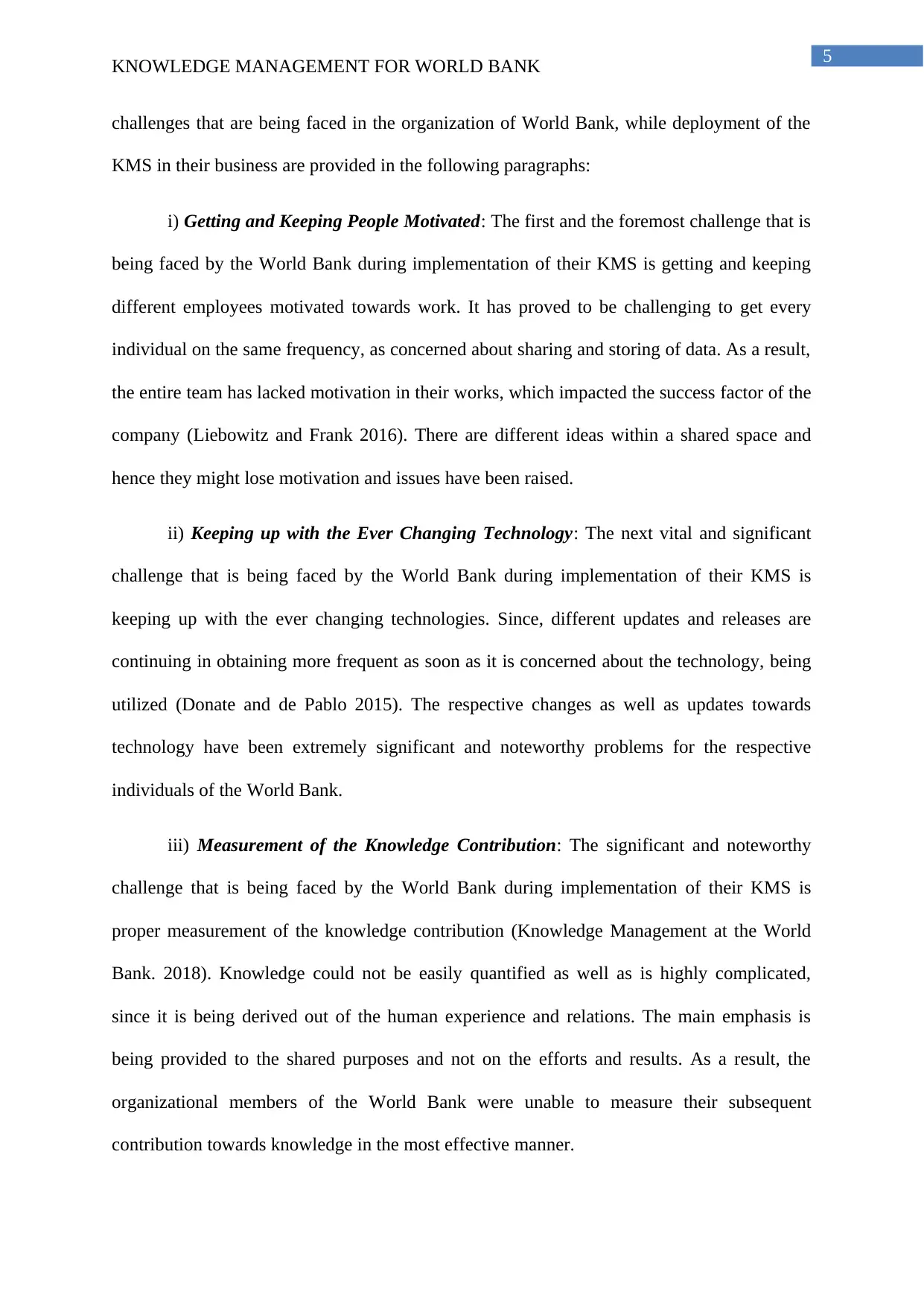
5
KNOWLEDGE MANAGEMENT FOR WORLD BANK
challenges that are being faced in the organization of World Bank, while deployment of the
KMS in their business are provided in the following paragraphs:
i) Getting and Keeping People Motivated: The first and the foremost challenge that is
being faced by the World Bank during implementation of their KMS is getting and keeping
different employees motivated towards work. It has proved to be challenging to get every
individual on the same frequency, as concerned about sharing and storing of data. As a result,
the entire team has lacked motivation in their works, which impacted the success factor of the
company (Liebowitz and Frank 2016). There are different ideas within a shared space and
hence they might lose motivation and issues have been raised.
ii) Keeping up with the Ever Changing Technology: The next vital and significant
challenge that is being faced by the World Bank during implementation of their KMS is
keeping up with the ever changing technologies. Since, different updates and releases are
continuing in obtaining more frequent as soon as it is concerned about the technology, being
utilized (Donate and de Pablo 2015). The respective changes as well as updates towards
technology have been extremely significant and noteworthy problems for the respective
individuals of the World Bank.
iii) Measurement of the Knowledge Contribution: The significant and noteworthy
challenge that is being faced by the World Bank during implementation of their KMS is
proper measurement of the knowledge contribution (Knowledge Management at the World
Bank. 2018). Knowledge could not be easily quantified as well as is highly complicated,
since it is being derived out of the human experience and relations. The main emphasis is
being provided to the shared purposes and not on the efforts and results. As a result, the
organizational members of the World Bank were unable to measure their subsequent
contribution towards knowledge in the most effective manner.
KNOWLEDGE MANAGEMENT FOR WORLD BANK
challenges that are being faced in the organization of World Bank, while deployment of the
KMS in their business are provided in the following paragraphs:
i) Getting and Keeping People Motivated: The first and the foremost challenge that is
being faced by the World Bank during implementation of their KMS is getting and keeping
different employees motivated towards work. It has proved to be challenging to get every
individual on the same frequency, as concerned about sharing and storing of data. As a result,
the entire team has lacked motivation in their works, which impacted the success factor of the
company (Liebowitz and Frank 2016). There are different ideas within a shared space and
hence they might lose motivation and issues have been raised.
ii) Keeping up with the Ever Changing Technology: The next vital and significant
challenge that is being faced by the World Bank during implementation of their KMS is
keeping up with the ever changing technologies. Since, different updates and releases are
continuing in obtaining more frequent as soon as it is concerned about the technology, being
utilized (Donate and de Pablo 2015). The respective changes as well as updates towards
technology have been extremely significant and noteworthy problems for the respective
individuals of the World Bank.
iii) Measurement of the Knowledge Contribution: The significant and noteworthy
challenge that is being faced by the World Bank during implementation of their KMS is
proper measurement of the knowledge contribution (Knowledge Management at the World
Bank. 2018). Knowledge could not be easily quantified as well as is highly complicated,
since it is being derived out of the human experience and relations. The main emphasis is
being provided to the shared purposes and not on the efforts and results. As a result, the
organizational members of the World Bank were unable to measure their subsequent
contribution towards knowledge in the most effective manner.
⊘ This is a preview!⊘
Do you want full access?
Subscribe today to unlock all pages.

Trusted by 1+ million students worldwide
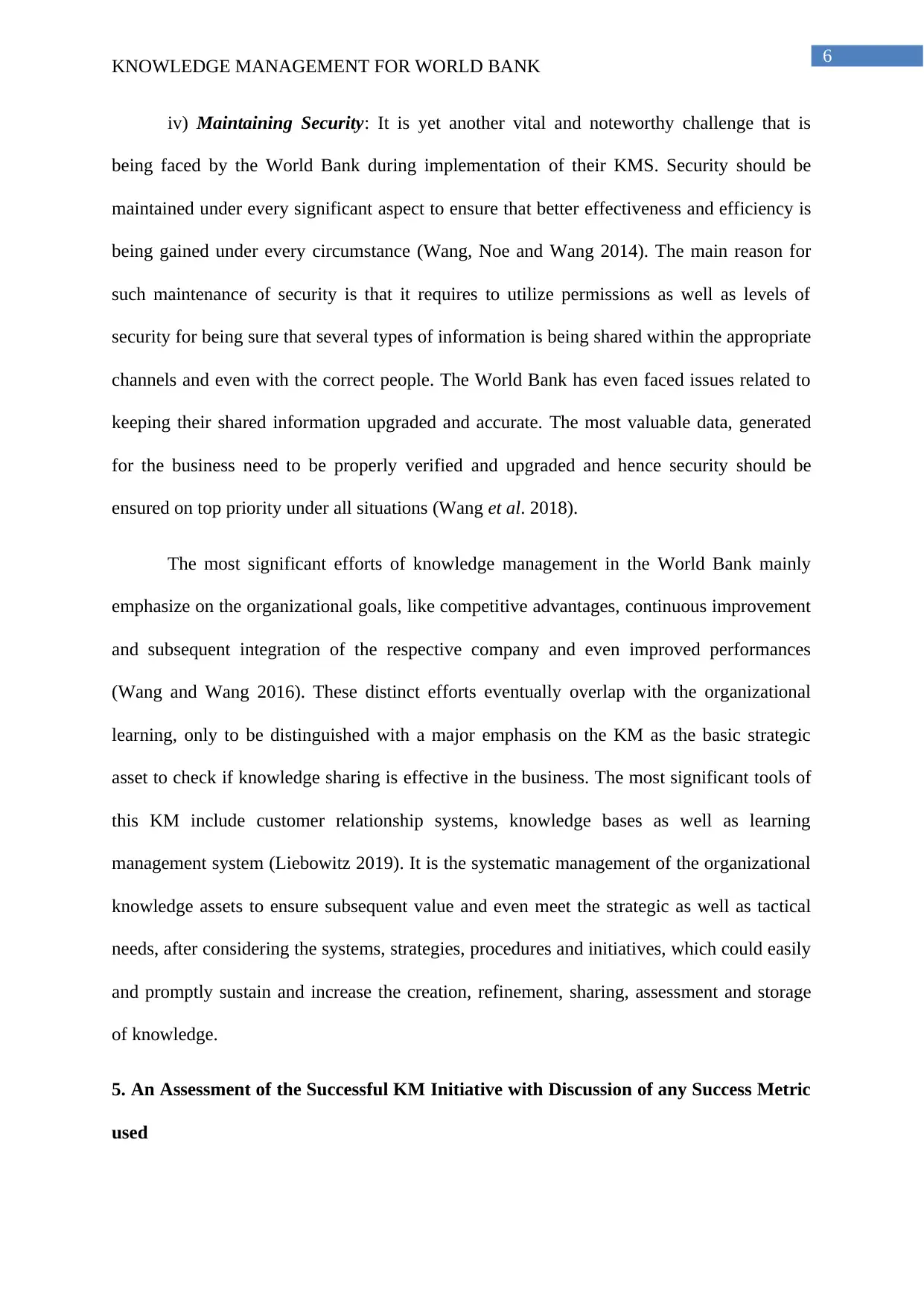
6
KNOWLEDGE MANAGEMENT FOR WORLD BANK
iv) Maintaining Security: It is yet another vital and noteworthy challenge that is
being faced by the World Bank during implementation of their KMS. Security should be
maintained under every significant aspect to ensure that better effectiveness and efficiency is
being gained under every circumstance (Wang, Noe and Wang 2014). The main reason for
such maintenance of security is that it requires to utilize permissions as well as levels of
security for being sure that several types of information is being shared within the appropriate
channels and even with the correct people. The World Bank has even faced issues related to
keeping their shared information upgraded and accurate. The most valuable data, generated
for the business need to be properly verified and upgraded and hence security should be
ensured on top priority under all situations (Wang et al. 2018).
The most significant efforts of knowledge management in the World Bank mainly
emphasize on the organizational goals, like competitive advantages, continuous improvement
and subsequent integration of the respective company and even improved performances
(Wang and Wang 2016). These distinct efforts eventually overlap with the organizational
learning, only to be distinguished with a major emphasis on the KM as the basic strategic
asset to check if knowledge sharing is effective in the business. The most significant tools of
this KM include customer relationship systems, knowledge bases as well as learning
management system (Liebowitz 2019). It is the systematic management of the organizational
knowledge assets to ensure subsequent value and even meet the strategic as well as tactical
needs, after considering the systems, strategies, procedures and initiatives, which could easily
and promptly sustain and increase the creation, refinement, sharing, assessment and storage
of knowledge.
5. An Assessment of the Successful KM Initiative with Discussion of any Success Metric
used
KNOWLEDGE MANAGEMENT FOR WORLD BANK
iv) Maintaining Security: It is yet another vital and noteworthy challenge that is
being faced by the World Bank during implementation of their KMS. Security should be
maintained under every significant aspect to ensure that better effectiveness and efficiency is
being gained under every circumstance (Wang, Noe and Wang 2014). The main reason for
such maintenance of security is that it requires to utilize permissions as well as levels of
security for being sure that several types of information is being shared within the appropriate
channels and even with the correct people. The World Bank has even faced issues related to
keeping their shared information upgraded and accurate. The most valuable data, generated
for the business need to be properly verified and upgraded and hence security should be
ensured on top priority under all situations (Wang et al. 2018).
The most significant efforts of knowledge management in the World Bank mainly
emphasize on the organizational goals, like competitive advantages, continuous improvement
and subsequent integration of the respective company and even improved performances
(Wang and Wang 2016). These distinct efforts eventually overlap with the organizational
learning, only to be distinguished with a major emphasis on the KM as the basic strategic
asset to check if knowledge sharing is effective in the business. The most significant tools of
this KM include customer relationship systems, knowledge bases as well as learning
management system (Liebowitz 2019). It is the systematic management of the organizational
knowledge assets to ensure subsequent value and even meet the strategic as well as tactical
needs, after considering the systems, strategies, procedures and initiatives, which could easily
and promptly sustain and increase the creation, refinement, sharing, assessment and storage
of knowledge.
5. An Assessment of the Successful KM Initiative with Discussion of any Success Metric
used
Paraphrase This Document
Need a fresh take? Get an instant paraphrase of this document with our AI Paraphraser
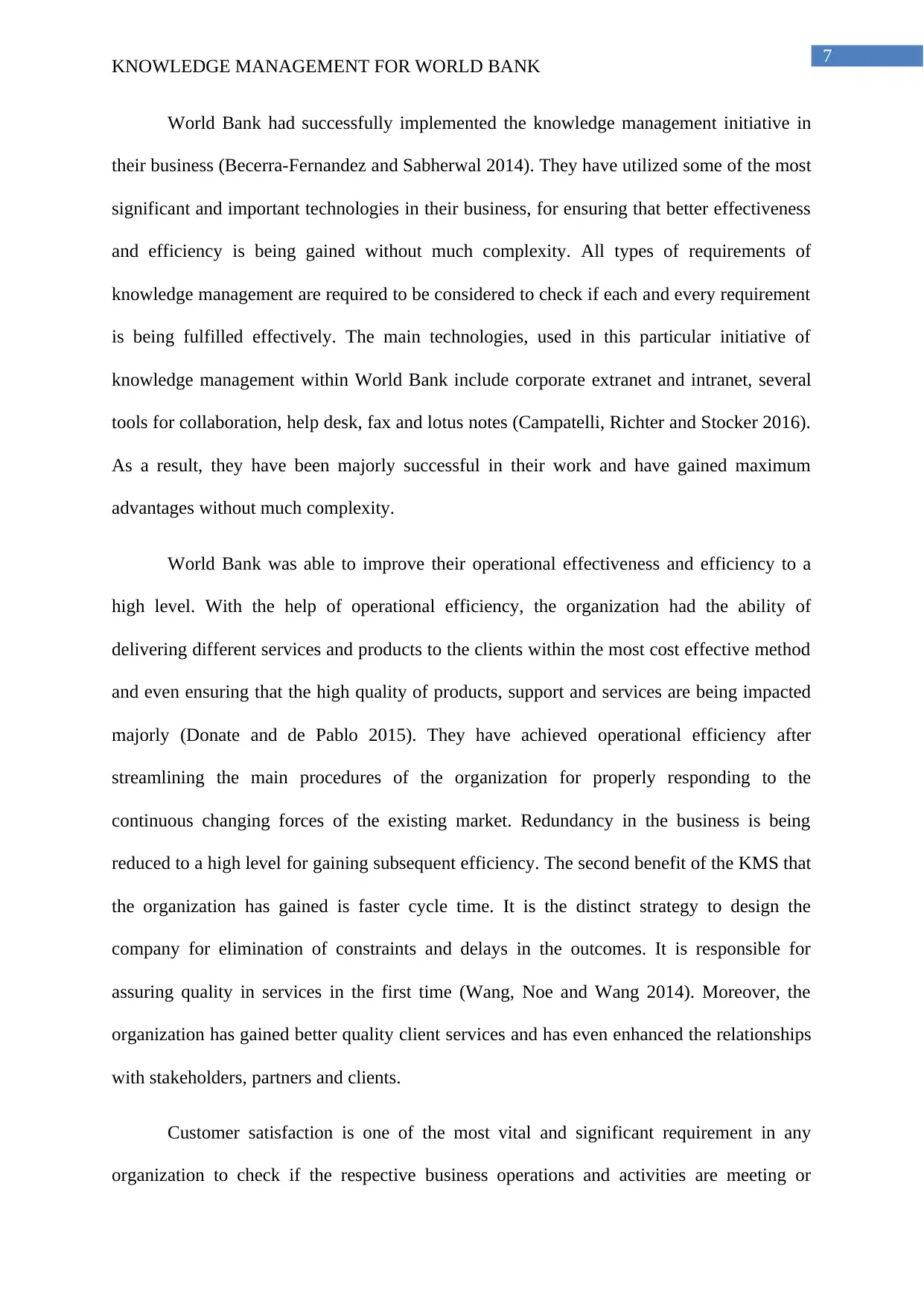
7
KNOWLEDGE MANAGEMENT FOR WORLD BANK
World Bank had successfully implemented the knowledge management initiative in
their business (Becerra-Fernandez and Sabherwal 2014). They have utilized some of the most
significant and important technologies in their business, for ensuring that better effectiveness
and efficiency is being gained without much complexity. All types of requirements of
knowledge management are required to be considered to check if each and every requirement
is being fulfilled effectively. The main technologies, used in this particular initiative of
knowledge management within World Bank include corporate extranet and intranet, several
tools for collaboration, help desk, fax and lotus notes (Campatelli, Richter and Stocker 2016).
As a result, they have been majorly successful in their work and have gained maximum
advantages without much complexity.
World Bank was able to improve their operational effectiveness and efficiency to a
high level. With the help of operational efficiency, the organization had the ability of
delivering different services and products to the clients within the most cost effective method
and even ensuring that the high quality of products, support and services are being impacted
majorly (Donate and de Pablo 2015). They have achieved operational efficiency after
streamlining the main procedures of the organization for properly responding to the
continuous changing forces of the existing market. Redundancy in the business is being
reduced to a high level for gaining subsequent efficiency. The second benefit of the KMS that
the organization has gained is faster cycle time. It is the distinct strategy to design the
company for elimination of constraints and delays in the outcomes. It is responsible for
assuring quality in services in the first time (Wang, Noe and Wang 2014). Moreover, the
organization has gained better quality client services and has even enhanced the relationships
with stakeholders, partners and clients.
Customer satisfaction is one of the most vital and significant requirement in any
organization to check if the respective business operations and activities are meeting or
KNOWLEDGE MANAGEMENT FOR WORLD BANK
World Bank had successfully implemented the knowledge management initiative in
their business (Becerra-Fernandez and Sabherwal 2014). They have utilized some of the most
significant and important technologies in their business, for ensuring that better effectiveness
and efficiency is being gained without much complexity. All types of requirements of
knowledge management are required to be considered to check if each and every requirement
is being fulfilled effectively. The main technologies, used in this particular initiative of
knowledge management within World Bank include corporate extranet and intranet, several
tools for collaboration, help desk, fax and lotus notes (Campatelli, Richter and Stocker 2016).
As a result, they have been majorly successful in their work and have gained maximum
advantages without much complexity.
World Bank was able to improve their operational effectiveness and efficiency to a
high level. With the help of operational efficiency, the organization had the ability of
delivering different services and products to the clients within the most cost effective method
and even ensuring that the high quality of products, support and services are being impacted
majorly (Donate and de Pablo 2015). They have achieved operational efficiency after
streamlining the main procedures of the organization for properly responding to the
continuous changing forces of the existing market. Redundancy in the business is being
reduced to a high level for gaining subsequent efficiency. The second benefit of the KMS that
the organization has gained is faster cycle time. It is the distinct strategy to design the
company for elimination of constraints and delays in the outcomes. It is responsible for
assuring quality in services in the first time (Wang, Noe and Wang 2014). Moreover, the
organization has gained better quality client services and has even enhanced the relationships
with stakeholders, partners and clients.
Customer satisfaction is one of the most vital and significant requirement in any
organization to check if the respective business operations and activities are meeting or
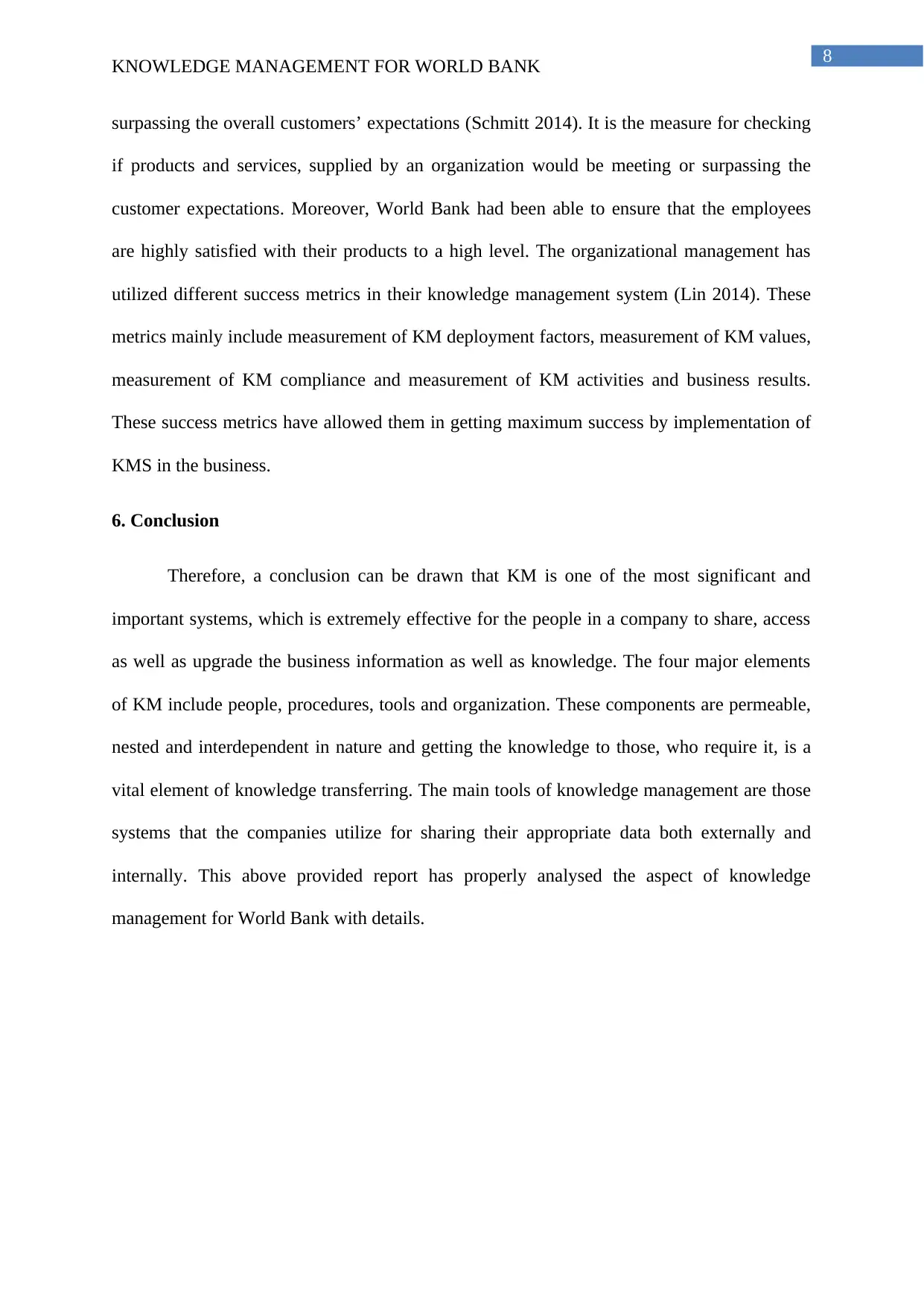
8
KNOWLEDGE MANAGEMENT FOR WORLD BANK
surpassing the overall customers’ expectations (Schmitt 2014). It is the measure for checking
if products and services, supplied by an organization would be meeting or surpassing the
customer expectations. Moreover, World Bank had been able to ensure that the employees
are highly satisfied with their products to a high level. The organizational management has
utilized different success metrics in their knowledge management system (Lin 2014). These
metrics mainly include measurement of KM deployment factors, measurement of KM values,
measurement of KM compliance and measurement of KM activities and business results.
These success metrics have allowed them in getting maximum success by implementation of
KMS in the business.
6. Conclusion
Therefore, a conclusion can be drawn that KM is one of the most significant and
important systems, which is extremely effective for the people in a company to share, access
as well as upgrade the business information as well as knowledge. The four major elements
of KM include people, procedures, tools and organization. These components are permeable,
nested and interdependent in nature and getting the knowledge to those, who require it, is a
vital element of knowledge transferring. The main tools of knowledge management are those
systems that the companies utilize for sharing their appropriate data both externally and
internally. This above provided report has properly analysed the aspect of knowledge
management for World Bank with details.
KNOWLEDGE MANAGEMENT FOR WORLD BANK
surpassing the overall customers’ expectations (Schmitt 2014). It is the measure for checking
if products and services, supplied by an organization would be meeting or surpassing the
customer expectations. Moreover, World Bank had been able to ensure that the employees
are highly satisfied with their products to a high level. The organizational management has
utilized different success metrics in their knowledge management system (Lin 2014). These
metrics mainly include measurement of KM deployment factors, measurement of KM values,
measurement of KM compliance and measurement of KM activities and business results.
These success metrics have allowed them in getting maximum success by implementation of
KMS in the business.
6. Conclusion
Therefore, a conclusion can be drawn that KM is one of the most significant and
important systems, which is extremely effective for the people in a company to share, access
as well as upgrade the business information as well as knowledge. The four major elements
of KM include people, procedures, tools and organization. These components are permeable,
nested and interdependent in nature and getting the knowledge to those, who require it, is a
vital element of knowledge transferring. The main tools of knowledge management are those
systems that the companies utilize for sharing their appropriate data both externally and
internally. This above provided report has properly analysed the aspect of knowledge
management for World Bank with details.
⊘ This is a preview!⊘
Do you want full access?
Subscribe today to unlock all pages.

Trusted by 1+ million students worldwide
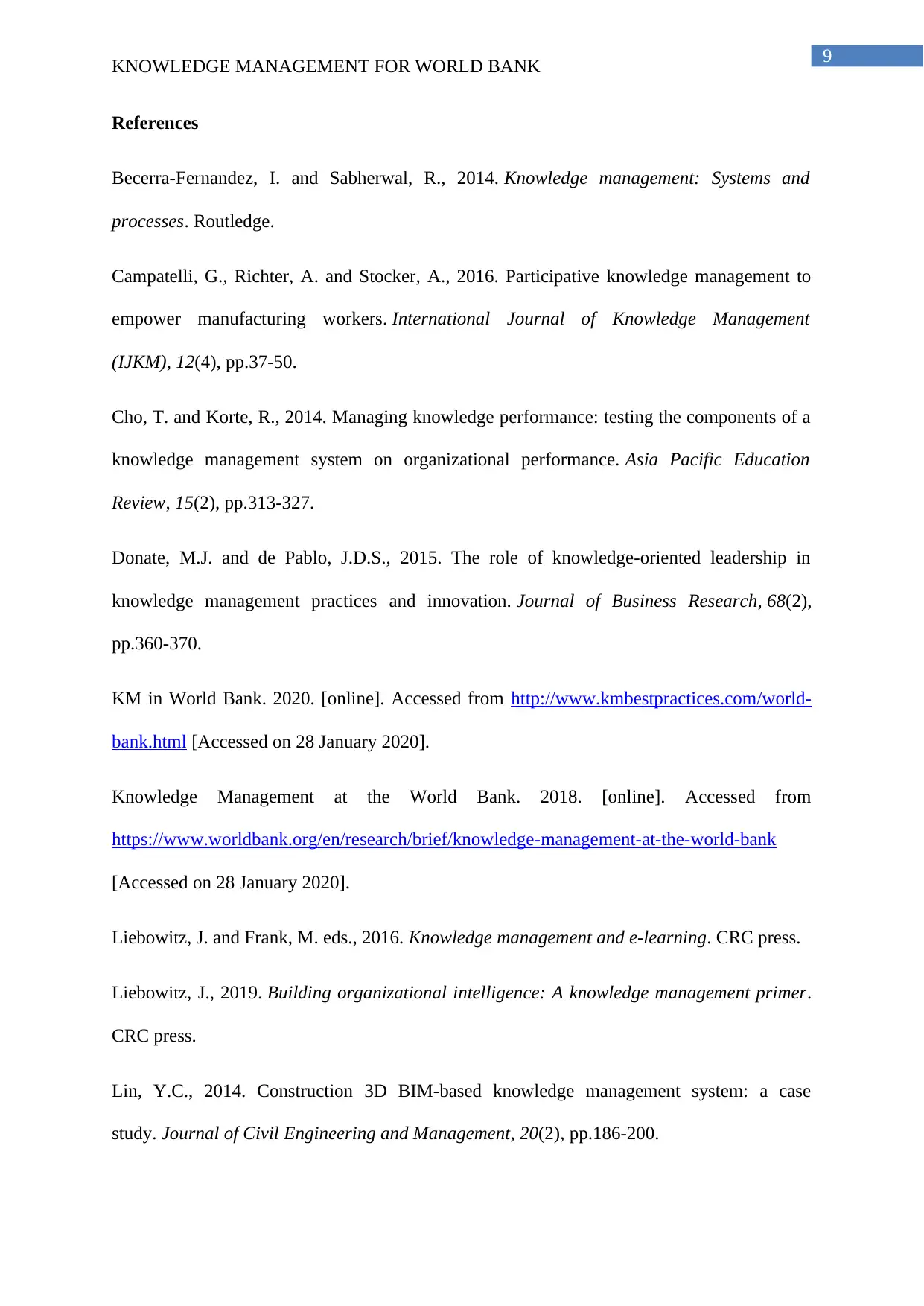
9
KNOWLEDGE MANAGEMENT FOR WORLD BANK
References
Becerra-Fernandez, I. and Sabherwal, R., 2014. Knowledge management: Systems and
processes. Routledge.
Campatelli, G., Richter, A. and Stocker, A., 2016. Participative knowledge management to
empower manufacturing workers. International Journal of Knowledge Management
(IJKM), 12(4), pp.37-50.
Cho, T. and Korte, R., 2014. Managing knowledge performance: testing the components of a
knowledge management system on organizational performance. Asia Pacific Education
Review, 15(2), pp.313-327.
Donate, M.J. and de Pablo, J.D.S., 2015. The role of knowledge-oriented leadership in
knowledge management practices and innovation. Journal of Business Research, 68(2),
pp.360-370.
KM in World Bank. 2020. [online]. Accessed from http://www.kmbestpractices.com/world-
bank.html [Accessed on 28 January 2020].
Knowledge Management at the World Bank. 2018. [online]. Accessed from
https://www.worldbank.org/en/research/brief/knowledge-management-at-the-world-bank
[Accessed on 28 January 2020].
Liebowitz, J. and Frank, M. eds., 2016. Knowledge management and e-learning. CRC press.
Liebowitz, J., 2019. Building organizational intelligence: A knowledge management primer.
CRC press.
Lin, Y.C., 2014. Construction 3D BIM-based knowledge management system: a case
study. Journal of Civil Engineering and Management, 20(2), pp.186-200.
KNOWLEDGE MANAGEMENT FOR WORLD BANK
References
Becerra-Fernandez, I. and Sabherwal, R., 2014. Knowledge management: Systems and
processes. Routledge.
Campatelli, G., Richter, A. and Stocker, A., 2016. Participative knowledge management to
empower manufacturing workers. International Journal of Knowledge Management
(IJKM), 12(4), pp.37-50.
Cho, T. and Korte, R., 2014. Managing knowledge performance: testing the components of a
knowledge management system on organizational performance. Asia Pacific Education
Review, 15(2), pp.313-327.
Donate, M.J. and de Pablo, J.D.S., 2015. The role of knowledge-oriented leadership in
knowledge management practices and innovation. Journal of Business Research, 68(2),
pp.360-370.
KM in World Bank. 2020. [online]. Accessed from http://www.kmbestpractices.com/world-
bank.html [Accessed on 28 January 2020].
Knowledge Management at the World Bank. 2018. [online]. Accessed from
https://www.worldbank.org/en/research/brief/knowledge-management-at-the-world-bank
[Accessed on 28 January 2020].
Liebowitz, J. and Frank, M. eds., 2016. Knowledge management and e-learning. CRC press.
Liebowitz, J., 2019. Building organizational intelligence: A knowledge management primer.
CRC press.
Lin, Y.C., 2014. Construction 3D BIM-based knowledge management system: a case
study. Journal of Civil Engineering and Management, 20(2), pp.186-200.
Paraphrase This Document
Need a fresh take? Get an instant paraphrase of this document with our AI Paraphraser
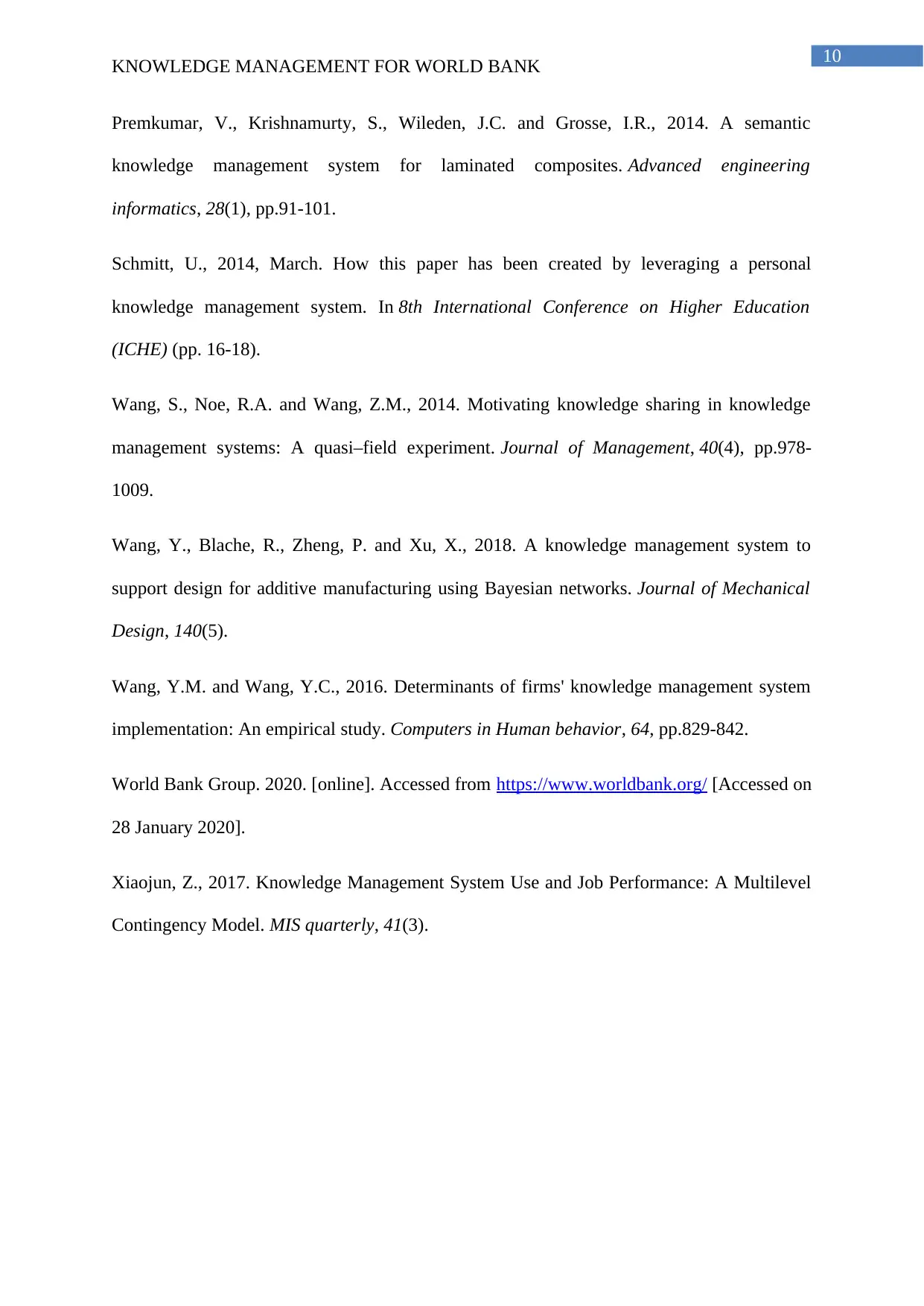
10
KNOWLEDGE MANAGEMENT FOR WORLD BANK
Premkumar, V., Krishnamurty, S., Wileden, J.C. and Grosse, I.R., 2014. A semantic
knowledge management system for laminated composites. Advanced engineering
informatics, 28(1), pp.91-101.
Schmitt, U., 2014, March. How this paper has been created by leveraging a personal
knowledge management system. In 8th International Conference on Higher Education
(ICHE) (pp. 16-18).
Wang, S., Noe, R.A. and Wang, Z.M., 2014. Motivating knowledge sharing in knowledge
management systems: A quasi–field experiment. Journal of Management, 40(4), pp.978-
1009.
Wang, Y., Blache, R., Zheng, P. and Xu, X., 2018. A knowledge management system to
support design for additive manufacturing using Bayesian networks. Journal of Mechanical
Design, 140(5).
Wang, Y.M. and Wang, Y.C., 2016. Determinants of firms' knowledge management system
implementation: An empirical study. Computers in Human behavior, 64, pp.829-842.
World Bank Group. 2020. [online]. Accessed from https://www.worldbank.org/ [Accessed on
28 January 2020].
Xiaojun, Z., 2017. Knowledge Management System Use and Job Performance: A Multilevel
Contingency Model. MIS quarterly, 41(3).
KNOWLEDGE MANAGEMENT FOR WORLD BANK
Premkumar, V., Krishnamurty, S., Wileden, J.C. and Grosse, I.R., 2014. A semantic
knowledge management system for laminated composites. Advanced engineering
informatics, 28(1), pp.91-101.
Schmitt, U., 2014, March. How this paper has been created by leveraging a personal
knowledge management system. In 8th International Conference on Higher Education
(ICHE) (pp. 16-18).
Wang, S., Noe, R.A. and Wang, Z.M., 2014. Motivating knowledge sharing in knowledge
management systems: A quasi–field experiment. Journal of Management, 40(4), pp.978-
1009.
Wang, Y., Blache, R., Zheng, P. and Xu, X., 2018. A knowledge management system to
support design for additive manufacturing using Bayesian networks. Journal of Mechanical
Design, 140(5).
Wang, Y.M. and Wang, Y.C., 2016. Determinants of firms' knowledge management system
implementation: An empirical study. Computers in Human behavior, 64, pp.829-842.
World Bank Group. 2020. [online]. Accessed from https://www.worldbank.org/ [Accessed on
28 January 2020].
Xiaojun, Z., 2017. Knowledge Management System Use and Job Performance: A Multilevel
Contingency Model. MIS quarterly, 41(3).
1 out of 11
Related Documents
Your All-in-One AI-Powered Toolkit for Academic Success.
+13062052269
info@desklib.com
Available 24*7 on WhatsApp / Email
![[object Object]](/_next/static/media/star-bottom.7253800d.svg)
Unlock your academic potential
Copyright © 2020–2025 A2Z Services. All Rights Reserved. Developed and managed by ZUCOL.




